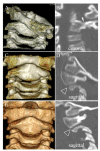Spontaneous Osseous Fusion after Remodeling Therapy for Chronic Atlantoaxial Rotatory Fixation and Recovery Mechanism of Rotatory Range of Motion of the Cervical Spine
- PMID: 35329830
- PMCID: PMC8949716
- DOI: 10.3390/jcm11061504
Spontaneous Osseous Fusion after Remodeling Therapy for Chronic Atlantoaxial Rotatory Fixation and Recovery Mechanism of Rotatory Range of Motion of the Cervical Spine
Abstract
We aimed to investigate the risk factors of spontaneous osseous fusion (SOF) of the atlantoaxial joint after closed reduction under general anesthesia followed by halo fixation (remodeling therapy) for chronic atlantoaxial rotatory fixation, and to elucidate the recovery mechanism of the rotatory range of motion (ROM) after halo removal. Twelve patients who underwent remodeling therapy were retrospectively reviewed. Five patients with SOF were categorized as the fusion group and seven patients without SOF as the non-fusion group. Three dimensional CT was used to detect direct osseous contact (DOC) of facet joints before and during halo fixation, while dynamic CT at neutral and maximally rotated head positions was performed to measure rotatory ROM after halo removal. The duration from onset to initial visit was significantly longer (3.2 vs. 5.7 months, p = 0.04), incidence of DOC during halo fixation was higher (0/7 [0%] vs. 4/5 [80%], p = 0.004), and segmental rotatory ROM of Occiput/C1 (Oc/C1) at final follow-up was larger (9.8 vs. 20.1 degrees, p = 0.003) in the fusion group. Long duration from the onset to the initial visit might induce irreversible damage to the articular surface of the affected facet, which was confirmed as DOC during halo fixation and resulted in SOF. Long duration from the onset to the initial visit and DOC during halo fixation could be used to suggest the risk for SOF. Nonetheless, rotatory ROM of Oc/C1 increased to compensate for SOF.
Keywords: atlantoaxial rotatory fixation (AARF); chronic AARF; facet deformity; remodeling therapy; spontaneous osseous fusion.
Conflict of interest statement
The authors declare no conflict of interest.
Figures


Similar articles
-
Remodeling of C2 facet deformity prevents recurrent subluxation in patients with chronic atlantoaxial rotatory fixation: a novel strategy for treatment of chronic atlantoaxial rotatory fixation.Spine (Phila Pa 1976). 2011 Feb 15;36(4):E256-62. doi: 10.1097/BRS.0b013e3181d8bbdd. Spine (Phila Pa 1976). 2011. PMID: 21192309
-
Atlantoaxial rotatory fixation: part 3-a prospective study of the clinical manifestation, diagnosis, management, and outcome of children with alantoaxial rotatory fixation.Neurosurgery. 2005 Nov;57(5):954-72; discussion 954-72. doi: 10.1227/01.neu.0000180052.81699.81. Neurosurgery. 2005. PMID: 16284565 Clinical Trial.
-
Management of chronic atlantoaxial rotatory fixation.Spine (Phila Pa 1976). 2012 Mar 1;37(5):E278-85. doi: 10.1097/BRS.0b013e31823cc2ea. Spine (Phila Pa 1976). 2012. PMID: 22281477 Review.
-
Rotatory Subluxation and Facet Deformity in the Atlanto-occipital Joint in Patients with Chronic Atlantoaxial Rotatory Fixation: Two Case Reports.J Orthop Case Rep. 2017 Nov-Dec;7(6):59-63. doi: 10.13107/jocr.2250-0685.950. J Orthop Case Rep. 2017. PMID: 29600213 Free PMC article.
-
Successful reduction for a pediatric chronic atlantoaxial rotatory fixation (Grisel syndrome) with long-term halter traction: case report.Spine (Phila Pa 1976). 2005 Aug 1;30(15):E444-9. doi: 10.1097/01.brs.0000172226.35474.fe. Spine (Phila Pa 1976). 2005. PMID: 16094264 Review.
References
-
- Smoker W.R. Congenital anomalies of the cervical spine. Neuroimag. Clin. N. Am. 1995;5:427–449. - PubMed
LinkOut - more resources
Full Text Sources

